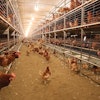The casual web user could draw a conclusion that companies posted on the USDA's Food Safety Inspection Service (FSIS) Web site produce substandard products.
The reality is far different. None of the products from these plants is adulterated, and the overwhelming majority of listed plants are meeting or exceeding the regulatory standard. Even those plants that currently do not meet the standard are part of companies that have plants performing at the highest levels.
Chicken plants are posted by category based on salmonella test results. Category I plants are not listed, as they are exceeding the regulatory standard by at least 50 percent. Category II plants are meeting or exceeding the performance standard, but not by 50 percent or more. Category III plants do not meet the standard.
Originally for plant use
Salmonella performance standards were created in 1996 as a process-control tool, not as a measure of the safety of specific products. Originally, FSIS intended to use the test results only to help plants recognize when their food-safety plans might need adjusting; now, they are being presented in a fashion that may lead individual consumers, retail stores and foodservice establishments to believe that only products from Category I plants are truly "safe."
Even the categories now posted were not established as a referendum on product safety but as a tool to help the agency better allocate inspection resources.
NTF, the National Chicken Council (NCC) and others also have raised concerns about FSIS' categorization method. According to USDA, a company must have two consecutive sample sets completed to be elevated to Category I, yet a single sample set is enough to be dropped to Category II.
Linking to the consumer food safety advice at www.fsis.usda.gov/Be_FoodSafe/index.asp for proper handling and cooking procedures would be an important consumer education tool in putting some context to FSIS salmonella category postings.
Potential turkey plant postings
There is currently no clear indication as to when other meat and poultry facility categories will be posted. However, if the agency were to post turkey processing facility results, nearly 100 percent of the establishments that have completed at least two sample sets would be in Category I, so few, if any, would be listed. The turkey industry has always placed the highest priority on food safety and has numerous best management practices to ensure the production of the highest quality, safest product possible.
Normally smart exemption
In other news, House Energy and Commerce Committee Chairman John Dingell, D-Mich., sent a letter to EPA Administrator Stephen L. Johnson expressing opposition to the proposed reporting exemption for air releases from animal waste under the Comprehensive Environmental Response, Compensation and Liability Act (CERCLA) and the Emergency Planning and Community Right-to-Know Act (EPCRA). Dingell's committee has jurisdiction over CERCLA and EPCRA.
This comes on the heels of comments due to EPA in late March on the exemption, which the poultry industry strongly supports and that was a result of a 2005 petition from NTF, NCC and the U.S. Poultry and Egg Association.
Just before Christmas, EPA proposed granting poultry farmers an exemption from reporting "emissions" that are the normal consequences of livestock and poultry operations.
In comments submitted to EPA, NTF stated that putting these types of emissions under CERCLA/EPCRA emergency reporting requirements would needlessly burden both 40,000 family farmers and many local fire and rescue services with paperwork and unnecessary communications.
EPA received more than 520 comments supporting the poultry waste exemption.


















